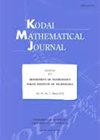泛间Teichmüller理论中的显式估计
IF 0.5
4区 数学
Q4 MATHEMATICS
引用次数: 1
摘要
在关于泛Teichmüller理论的一系列论文的最后一篇论文中,Mochizuki验证了数域上Vojta、ABC和Szpiro猜想的各种数值无效版本。在本文中,我们获得了Mochizuki结果的各种数值有效版本。为了获得这些结果,我们首先建立了étaleθ函数理论的一个版本,该理论在任意坏的地方正确地起作用,即,甚至在划分素数“2”的坏的地方。然后,我们继续讨论étaleθ函数理论的这种修改版本是如何影响相互通用的Teichmüller理论的。最后,通过应用我们稍微修改过的泛际Teichmüller理论,以及关于高度的各种显式估计、“算术”椭圆曲线的j不变量和素数定理,我们验证了上述Mochizuki结果的数值有效版本。这些数值有效的版本意味着有效的丢番图结果,例如单复数域[即有理数域或虚二次域]上ABC不等式的有效版本,以及Szpiro猜想的有效版本。我们还得到了关于“费马最后定理”(FLT)的一个显式估计,即对于素数指数>1.615·10,FLT成立——根据Coppersmith的一个数值结果,这足以给出FLT第一种情况的另一种证明。在FLT的第二种情况下,如果将本文的技术与Mihăilescu和Rassias的最新估计相结合,则下限“1.615.10”可以改进为“257”。这一估计,结合Vandiver的经典结果,得出了FLT第二种情况的替代证明。特别是,本文的结果,结合Vandiver、Coppersmith和Mihăilescu Rassias的结果,给出了Fermat最后定理的一个无条件的新的替代证明。本文章由计算机程序翻译,如有差异,请以英文原文为准。
Explicit estimates in inter-universal Teichmüller theory
In the final paper of a series of papers concerning interuniversal Teichmüller theory, Mochizuki verified various numerically non-effective versions of the Vojta, ABC, and Szpiro Conjectures over number fields. In the present paper, we obtain various numerically effective versions of Mochizuki’s results. In order to obtain these results, we first establish a version of the theory of étale theta functions that functions properly at arbitrary bad places, i.e., even bad places that divide the prime “2”. We then proceed to discuss how such a modified version of the theory of étale theta functions affects inter-universal Teichmüller theory. Finally, by applying our slightly modified version of inter-universal Teichmüller theory, together with various explicit estimates concerning heights, the j-invariants of “arithmetic” elliptic curves, and the prime number theorem, we verify the numerically effective versions of Mochizuki’s results referred to above. These numerically effective versions imply effective diophantine results such as an effective version of the ABC inequality over mono-complex number fields [i.e., the rational number field or an imaginary quadratic field] and effective versions of conjectures of Szpiro. We also obtain an explicit estimate concerning “Fermat’s Last Theorem” (FLT) — i.e., to the effect that FLT holds for prime exponents > 1.615 · 10 — which is sufficient, in light of a numerical result of Coppersmith, to give an alternative proof of the first case of FLT. In the second case of FLT, if one combines the techniques of the present paper with a recent estimate due to Mihăilescu and Rassias, then the lower bound “1.615 · 10” can be improved to “257”. This estimate, combined with a classical result of Vandiver, yields an alternative proof of the second case of FLT. In particular, the results of the present paper, combined with the results of Vandiver, Coppersmith, and Mihăilescu-Rassias, yield an unconditional new alternative proof of Fermat’s Last Theorem.
求助全文
通过发布文献求助,成功后即可免费获取论文全文。
去求助
来源期刊
CiteScore
0.90
自引率
0.00%
发文量
16
审稿时长
>12 weeks
期刊介绍:
Kodai Mathematical Journal is edited by the Department of Mathematics, Tokyo Institute of Technology. The journal was issued from 1949 until 1977 as Kodai Mathematical Seminar Reports, and was renewed in 1978 under the present name. The journal is published three times yearly and includes original papers in mathematics.

 求助内容:
求助内容: 应助结果提醒方式:
应助结果提醒方式:


